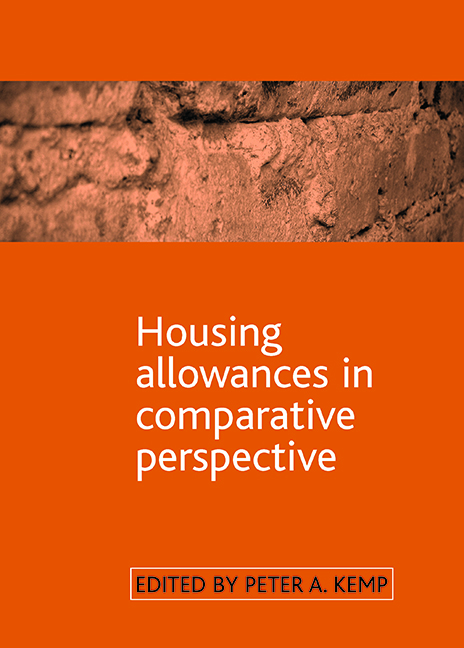Book contents
- Frontmatter
- Contents
- List of tables and figures
- Acknowledgements
- Notes on contributors
- one Housing allowances in context
- two Housing allowances and the restructuring of the Australian welfare state
- three The New Zealand experience of housing allowances
- four Canadian housing allowances
- five Housing allowances American style: the Housing Choice Voucher programme
- six Housing Benefit in Britain: a troubled history and uncertain future
- seven Housing allowances in France
- eight Housing allowances in Germany
- nine Housing allowances in the Netherlands: the struggle for budgetary controllability
- ten Housing allowance systems in Sweden
- eleven Housing allowances in the Czech Republic in comparative perspective
- twelve Housing allowances in the advanced welfare states
- Index
two - Housing allowances and the restructuring of the Australian welfare state
Published online by Cambridge University Press: 15 September 2022
- Frontmatter
- Contents
- List of tables and figures
- Acknowledgements
- Notes on contributors
- one Housing allowances in context
- two Housing allowances and the restructuring of the Australian welfare state
- three The New Zealand experience of housing allowances
- four Canadian housing allowances
- five Housing allowances American style: the Housing Choice Voucher programme
- six Housing Benefit in Britain: a troubled history and uncertain future
- seven Housing allowances in France
- eight Housing allowances in Germany
- nine Housing allowances in the Netherlands: the struggle for budgetary controllability
- ten Housing allowance systems in Sweden
- eleven Housing allowances in the Czech Republic in comparative perspective
- twelve Housing allowances in the advanced welfare states
- Index
Summary
Introduction
Housing allowances have become increasingly important in Australia since the early 1980s, both in terms of the number of households assisted and government expenditure. Increasing reliance by governments on housing allowances has not been the result of an explicit process of policy development. Instead, two different types of housing allowances developed gradually and incrementally within the housing assistance and income support systems. Housing allowances are specific to either the public or private rental sectors and are the product of considerable dualism in rental market structuring (Kemeny, 1995).
This chapter traces the development of both types of housing allowances and examines their role, design and impacts. It raises a number of current policy debates, including prospects for integration of the two housing allowance schemes, the implications of ‘welfare-to-work’ policies, the role of housing allowances in developing the not-for-profit housing sector, and issues associated with designing housing allowances for a large country with significant differences in housing sub-markets.
The context for government housing assistance in Australia
Housing in Australia is a market commodity, almost entirely in private ownership and in which access is determined primarily by ability to pay market prices. In 2001, almost seven in ten Australian households were homeowners. This high rate has changed little for 40 years but is now bolstered by the more than four in ten households who own their housing outright with no mortgage, as shown in Table 2.1. Almost three in ten Australian households rent their housing, predominantly from private landlords and real estate agents. There is also a small social housing sector comprising 5.4% of occupied private dwellings.
Australian governments use a range of policy instruments to achieve housing outcomes, including tax expenditures, supply subsidies to social housing providers and personal subsidies to households. The most significant of these in terms of dollar value are tax expenditures for homeowners, in particular, exemption of owner-occupied housing from capital gains tax. The most recent estimate for 2001 suggests that the dollar value of tax expenditures for homeowners (A$21 billion) is about five times greater than direct government outlays on housing programmes (A$4.2 billion), although the different nature of assistance and data problems make such a direct comparison difficult (Wang et al, 2004, p 2).
- Type
- Chapter
- Information
- Housing Allowances in Comparative Perspective , pp. 17 - 38Publisher: Bristol University PressPrint publication year: 2007

